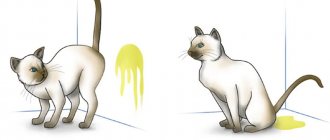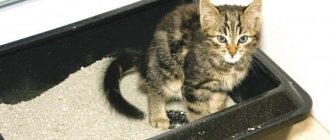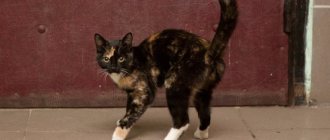The suffering of people whose cat began to shit in the wrong place is immeasurable. Most often in such a situation, the owner's bed and shoes, the threshold of the front door, the corners of rooms and the space under the bathroom suffer. You want to solve the problem as soon as possible, but in a hurry you can only make it worse: by not following the rules, it is easy to reinforce the animal’s erroneous behavior. We will tell you how to stop a cat from going to the toilet in the wrong place.
Why did the cat start shitting in the room?
The first thing you need to understand is why the cat began to upset its owners:
- This may be due to diseases of the gastrointestinal tract or genitourinary system.
- It is possible that the animal attracts attention in this way, showing that it needs help.
- Sometimes a cat’s toilet begins to be associated with pain. In this case, any attempts to return it to the tray will remain in vain until it is completely cured.
Important! If a cat experiences pain, pain or simply unpleasant sensations, if it cannot restrain involuntary urination, then educational measures are useless. In this case, urgent assistance from a veterinarian is necessary: a timely diagnosis and proper treatment will help solve the problem.
Main reasons not related to health:
- a significant change in the situation (moving, renovation, buying new furniture);
- non-acceptance of the premises where the toilet is installed;
- aversion to the smell of the material from which the tray is made (or its shape);
- antipathy to the filler (or its rare replacement);
- conflict between cats living together;
- lack of attention from the owners.
Sometimes an animal takes revenge for an insult in this way or protests if it doesn’t like something. This is his way of “explaining” to the owners: something is not as the cat wants. But there is no need to look for human logic and conscious behavior in such actions: everything is spontaneous, situational and subordinate to instincts.
Our article – rating of trays for cats – can help you with choosing the right accessory.
The reason can be elementary:
- the toilet was moved (turned);
- another cat went into the litter box;
- there is not enough food in the feeder and not enough water in the drinking bowl;
- The family pet is old, and these are age-related problems.
Sometimes a cat stops going because something startled her during a previous trip to the toilet: for example, someone suddenly walked by while the cat was doing her business.
A separate block is the natural need to mark the territory, protecting it from the encroachments of other animals or even guests who come to the house. And also in an effort to attract sexual partners. This is a powerful animal instinct, which cannot be overcome by educational measures.
How to treat a place where a cat shits
It is worth treating with sharply odorous substances so that the smell disappears completely and the cat no longer feels it. You can put onions in the place where the cat pooped; this is the most unpleasant smell for animals. And also wipe it several times with a manganese solution, and the cat will stop peeing anywhere.
Spray
If you can’t wean it off in other ways so that the cat doesn’t shit, you can use special repellents. Sprays specifically for cats are produced both with the aim of accustoming them to the litter box, and to scare them away from relieving themselves in an inappropriate place. They can be purchased at any pet store.
Folk remedies
People often use fir aromas, lemon, garlic and iodine to eliminate odor. These odorous products are used to treat areas where the cat has previously shitted.
DIY repeller
If a cat gets into the habit of shitting in flowers, in this case you can resort to tricks. For example, stick toothpicks into a pot, and she simply will not be able to settle down there.
And also use double-sided tape on the windowsill.
However, a clove of garlic or a piece of orange peel in the ground will not harm the flower, but will be an obstacle for the animal.
How to prevent cat misbehavior
You can never be sure of anything with a pet: it is a living creature that may have its own problems and its own views on how its living environment should be arranged. In order to protect your home as much as possible from surprises, the conditions for keeping the animal are thought out even before the mustachioed friend is brought into the house.
The cat loves cleanliness, order and clear organization of space. It would be wise to position the toilet in a way that she likes. Then she will agree to do her business where it is convenient for the owner.
Misbehavior in a cat can be prevented if:
- choose a toilet that your pet will like (even if you have to change several in a row);
- When purchasing a tray, take into account the size of the animal;
- place the tray in a secluded corner with 24-hour access to the room;
- place the feeding area away from the toilet;
- Do not place anything with a strong smell next door.
It is extremely important to clean your cat's litter box frequently:
- every time you change the filler;
- as soon as the smell appears;
- Trays used without filler are washed after each cat’s visit to the toilet.
The litter you choose is the one that suits your cat. They change it without waiting for a strong smell to appear, which is individual for each animal.
Sometimes a cat shits in the room because of helminths: the pain and itching force her to look for a place where she can wipe off the remnants of the discharge. Often she looks for something soft - a carpet, a bed or a sofa. To prevent this from happening, even a healthy cat needs to be given anti-worm medication from time to time.
If your cat has urinary incontinence caused by illness or old age, you can only protect your floors and carpets by buying her diapers. This decision will be the only correct one; it will completely eliminate hassle and dirt in the house.
If a kitten shits
A kitten that goes to the toilet in a place other than where it is supposed to is a special case. As a rule, it must be taught this by its mother or another adult cat. However, in practice this does not always happen. If a kitten is orphaned early or thrown out into the street by cruel owners, there is simply no one to teach it proper behavior. Even if the baby is lucky and has a recently whelped dog looking after him, she will not be able to “explain” to him how to use the litter box. The owner will have to deal with this himself. Fortunately, kittens very quickly understand what they want from them, and after being caught in time two or three times and taken to the potty, they decide that digging into the litter is much more interesting than scraping slippery parquet floors or cold tiles.
Place your baby in the litter box immediately after he has eaten or woken up. If everything went well, be sure to praise your pet. You can tell the rest of the family about his successes. Rest assured, your little pet understands perfectly well what you are talking about, especially if you don’t forget to back up your praise with a portion of treats.
If you have a very young kitten, do not let him explore all the rooms on the first day. It’s easy to get lost in a huge (by the standards of a tiny animal) house. What if he gets a tummy ache while traveling and there’s no cozy litter box nearby? In a few days, your mustachioed pet will stop hiding in the sofa at every rustle, get used to your voice, remember where his bowl and bowl of water are, learn to confidently use the litter box, and, by the way, will grow up a little. Then it will be possible to gradually introduce him to other rooms in the house.
By following these simple rules, you will quickly train your pet to use the litter box. If, nevertheless, a certain incident happens from time to time, do not scold the baby under any circumstances! Perhaps he is not feeling well. Many kittens, and adult cats too, when they have an upset stomach, prefer to poop on the floor or in a tray without litter. In this case, it is enough to adjust the pet’s diet - and the problem will be solved.
Methods to Avoid
Measures for raising an animal must be completely safe for its health.
Absolute taboo:
- beating;
- poking your nose into a puddle or pile;
- dousing with water;
- rough pushing towards the tray;
- shout.
All this will only frighten, provoke stress and ultimately have the opposite effect. The cat will become insecure and begin to look through all corners in search of something for which it will not be punished.
A little scolding is necessary, but only if the cat was caught “doing this.” Delayed punishment is pointless, because the cat will no longer understand what the owner’s aggression is connected with.
Sometimes it is advised to lock the cat in a cramped room with a litter tray: if it cannot find another place, it will begin to go there. But this method is also quite cruel. Such treatment can frighten, offend the animal and cause a persistent aversion to the toilet.
Expert advice
Among other tips, the most popular are the following:
- You should take a rag, wrap it around the animal’s neck and rub it in the corners where it often craps. Where it smells of its pheromones, the cat will not make a toilet.
- In places where the cat shits, you should place small bowls of food.
Expert advice - understand the reasons
The easiest way is to put a piece of toilet paper soaked in animal urine in the tray. This will clearly show where the toilet is. The cat will try to bury the paper. When digging, a reflex will work: if you dig a hole, why not use it? This way, the cat can get used to the litter box. But in this case, you need to make sure that the tray is in the right place. Carpets should be removed while the cat is litter training.
Important! Punish a pet only when caught at the scene of a crime, and not after some time.
It is possible to solve problems, but it requires attention and patience on the part of the owner. The moment a person takes a kitten into his home, he must immediately begin to accustom the animal to the tray. This must be done in such a way that the kitten learns to relieve itself in the right places. The animal should not be subjected to harsh training methods, as this will not bring any results. Usually kittens quickly get accustomed to a tray with a special filler. If an animal that has reached sexual maturity satisfies its needs in the wrong place, this may be a sign of possible health problems or marking the boundaries of its territory. In any case, you must first establish the reasons why the animal does not behave as expected, and then eliminate them.
How to stop a cat from pooping all over your apartment: proven methods
It is not at all difficult to train a small kitten to use a litter tray. But if an adult cat suddenly changes its habits, or the animal is taken from the street, only those who show patience and love will achieve success.
The owner needs to show the cat that he is against him shitting anywhere and take care of cleanliness:
- the dirty floor is immediately washed and disinfected;
- it is possible to use an odor repellent;
- soiled shoes are thoroughly cleaned and put away.
Many cats urinate in one litter box and defecate in another. In this case, the problem can be solved in the easiest way: just place two containers next to each other.
If the cat is left alone for a long time, you will have to get another potty, because this animal will not go into a dirty container.
Sometimes it is enough to change the brand of litter to the one the cat is used to. If there is a need to accustom the cat to a different litter, the change is made gradually, mixing the new brand with the old one in increasing proportions.
After making sure that the animal is healthy, you can apply educational measures:
- give a treat every time the cat goes into the litter box: to positively reinforce correct behavior;
- put a bowl of food where it is pooped: cats do not go to the toilet where they eat;
- in cases where “you can’t stock up on any bowls,” you can lay out dry food in areas that have been thoroughly washed of urine or feces beforehand.
If the cat gets into the habit of walking on any object that can be removed for a while (a rug, a chair), then it is better to take the thing out altogether or stop the cat’s access to the room. But it cannot be guaranteed that, having stopped shitting in the wrong place for some time, even for a long time, the cat will not eventually begin to use this thing as its toilet again.
A very effective way for a small kitten is to soak a cloth in his urine and put it in the tray. The smell will point the animal to the right place. The same can be done for an adult cat brought from the street.
A good method is to place the tray where the cat began to shit, gradually moving it to where the owner needs it. Often the cat obeys or does not notice the change in the position of the potty. But sometimes you have to come to terms and permanently move the tray to the corner chosen by the animal.
You can make a place favored by a cat inaccessible:
- cover with something that is better unpleasant for the paws;
- fence with a strip of double-sided tape;
- make inaccessible (fence, cover).
Sometimes it turns out to be effective to create a situation of discomfort at the moment when the cat settles down in the corner of its choice (unexpected appearance, clapping of hands). But the animal always understands that it is doing something bad, and tries to do it when no one is around. The owners will have to keep watch, and perhaps more than once.
To prevent a cat taken from the street from marking the entire apartment, you can collect its scent on a porous fabric (by rubbing it on the fur, for example) and spread its pieces around the apartment. Then the animal will understand that this is its territory, which does not need to be marked.
To prevent pets from spraying gonad secretions and urine around the apartment, males are castrated and females are sterilized. But if this is done late, when the behavior has already become entrenched, the operation will not get rid of the marks. Your veterinarian will help determine the correct age for this procedure.
An animal that shits in the wrong place in order to find a sexual partner can simply be given the opportunity to satisfy its instinct, and silence and cleanliness will return to the apartment.
There is one more absolute rule: a cat’s misdeed, committed in front of the owner, should never go uncondemned. Because the cat must clearly understand what is acceptable in its behavior and what is not.
How to stop a cat from peeing on the floor or carpet
First of all, try to clean everything thoroughly so that there is no smell left, as cats react to it, and history repeats itself. Try putting orange peels or pepper in those places; these smells will scare the animal away from these places.
Attention! Do not use vinegar, as it will only increase the smell of urine, and this will be an opportunity for more pranks.
Double-sided tape can also come to the rescue in this difficult matter. It is necessary to glue it to the floor, in the place where the cat previously pooped. And the next time he tries to do this again, he will stick his paws, feel discomfort, and refuse to visit these places.
Also, a cat will never do indecent acts where it smells itself. Wipe its face and fur with a dry cloth, then use it to walk over the carpet where the animal previously left puddles. In this way, the pet will quickly understand that it is forbidden to shit in this place.
Protecting your home with special tools
The industry produces many products for correcting animal behavior. At the pet store you can choose them in the form of a spray, powder, or emulsion.
There are drugs whose composition:
- attracts to the tray;
- scares away from the wrong place;
- deodorizes, neutralizes odors;
- disinfects;
- calms during heat.
If in doubt, you can contact your veterinarian, who will advise the most suitable drug for a particular breed and age of the animal. The fact is that some of them act differently on young or old, healthy or sick, castrated or giving birth animals. Only a specialist can choose an effective and harmless remedy for a specific pet.
Cat repellent to stop them from pooping
There is a wide choice of means and methods to treat the area where cats have pooped:
- Wipe the floor, walls and corners with a weak solution of vinegar or potassium permanganate
- alcohol for processing ;
- hydrogen peroxide has disinfectant properties and is also suitable for short circuits;
- iodine solution - add up to 15 drops to water;
- if a pet shits on the beds or flowers, then the area can be sprinkled with ground pepper ;
- laundry soap eliminates odor, you need to wash the surface with the solution;
- mix baking soda
- add a bite to the water in a 1:1 ratio, wipe the surface and then cover it with soda and hydrogen peroxide, after the mixture has dried, remove it;
- place a few lemon slices ;
Basically, they are available in the form of sprays. The most famous are from the company Antigadin and Emix spray.
The latter can be sprayed directly onto the cat tray and litter, as it eliminates all unpleasant odors from feces. Absolutely safe for animals and people.
There are special sprays for taming a cat to the litter box. You need to spray a small piece of paper with the product, then let your pet smell it and put it in the tray.
Popular disinfectants and taming agents:
- Hartz;
- Beafar is a large line of products in different forms: sprays, drops;
- A faithful friend - powder, detergent and spray;
- Zoovorsin - to remove odors from furniture and carpets;
- M. Kiss - spey, repeller and toilet tamer;
- Smart spray.
Traditional methods of dealing with the smell of cat urine
Cats have lived alongside humans for about 10,000 years. During this time, people managed to pick up odors that discourage cats from shitting where they shouldn’t. Not all of them are effective in our time. Moreover, each cat’s sense of smell is individual.
But you can, hoping for a positive effect, spread it out in places that have been washed from excrement:
- lemon, orange (you can put the peels in flower pots);
- mustard or very hot pepper;
- burnt paper or ashes;
- the owner's sweaty clothes.
Cat urine odors from objects, furniture, clothing and shoes can be eliminated using:
- iodine;
- alcohol;
- hydrogen peroxide.
As for bleach and vinegar, they are dangerous to health and completely useless: most likely, they will attract the pet even more to their favorite corner. Simply because they enhance the smell of urine.
What smells repel cats?
Cats are very sensitive to odors, so you can treat the damaged area with a certain product or solution so that in the future the pet does not relieve itself there.
Citrus
You can place orange or lemon peels in corners that are off-limits to your pet. For furniture, a polish with a citrus scent is suitable.
Vegetables
Cats don't like the smell of garlic and onions. To scare away the animal, you can grate these vegetables and place them in the right place, or fill them with water and wipe the surfaces with the prepared solution.
Perfumery
Pets are most sensitive to strong and persistent aromas. But here everything is individual. In addition, to scare away you need to use a large amount of perfume.
Essential oils
Some essential oils are disgusting to animals. Rosemary, lavender, mint, and citranella extract are great for these purposes. Oil is added to water and dripped onto the desired place so that the cat does not go there again.
Essential oils can be mixed with grated citrus peel or coffee grounds; such compositions will scare away your pet.
Some essential oils are disgusting to animals
Herbs
To repel, you need to prepare a decoction: pour boiling water over the leaves of rosemary, cayenne pepper, and lavender and let it brew. Using a spray bottle, spray onto desired areas.
Some spices repel cats: mustard, coriander, cinnamon, ground pepper, cumin.
Chemical substances
Cats have a negative attitude towards various chemicals: varnishes, shampoos, construction chemicals, detergents with a strong smell. You should use all this carefully so as not to irritate your cat’s nasal canals.
Vinegar
Vinegar occupies a leading position. A small drop of this product is enough to repel your pet.
Alcohol
You can wipe surfaces with alcohol, and a glass of alcohol left on the table overnight will discourage your pet from climbing on it.
If your cat begins to ignore the litter box and shits in different places, find out the reason and eliminate it, treat the favorite place with one of the listed products to remove unpleasant odors. For prevention purposes, use either natural repellents or special means for this purpose.
Sources:
https://www.odnadama.ru/dom/kak-mne-udalos-otuchit-koshku-gadit-v-nepolozhennom-meste/ https://gafki.ru/koshki/kak-otuchit-gadit-v-nepolozhennom- meste.html https://kotsobaka.com/koshki/bolezni-i-lechenie-k/gadit-sredstvo.html
Aids
If you were unable to stop your cat from crapping in the wrong place using the suggested remedies, you should try special medications that are sold in veterinary pharmacies.
The most popular domestically produced chemicals:
- “Don’t shit! Don't tag!";
- Antigadin;
- “Shit? No!";
- Fresh. Unlearning to shit.
Among the foreign-made products, the following drugs can be noted:
It is important to note that they must be used in strictly limited dosages in well-ventilated areas, otherwise their smell may cause discomfort in people.
You can try to neutralize the place where the animal went to the toilet using essential oils, but they are quite expensive and are not always effective. However, if you have an extra bottle lying around, it doesn’t hurt to try.
Gestrenol: scheme for using drops
Before using the drug on a cat that has gone on a spree, carefully read the instructions for use. Pay attention to precautions and dosage. This will allow you to achieve its maximum efficiency.
Most often, Gestrenol drops are applied to the animal’s nose so that it licks them off. This method is good because the product immediately enters his body and begins to act immediately. In rare cases, it is allowed to be added to food, but do not be surprised if your pet suddenly refuses the offered treat, because they smell foreign sex hormones.
We hope that our tips helped you train your pet to use the litter box. Happy re-education!
What not to do
Remember: being aggressive towards an animal is a surefire way to achieve nothing. So be patient. Your cat should feel safe in your company. Try not to show signs of impatience so as not to frighten the animal, but at the same time try to show him who is boss.
So, what should she do?
- Yell at the cat;
- drag to the tray;
- poking one's muzzle into feces.
At best, the response to such actions will be an angry hiss. At worst, the animal will become embittered and begin to deliberately throw “mines” at you.
If you see that an animal is starting to settle in the wrong place, try not to scare it away. A frightened cat may start to run away, as a result of which not only will you not achieve any benefit from the educational measures taken, but you will also be cleaning up feces throughout the apartment. The only correct step is to quickly but carefully grab the cat and transport it to the litter box before it has time to come to its senses.
If you have encouraged your cat to go to the toilet correctly with treats, you should not suddenly refuse them. Otherwise, the cat may take up the old habit, deciding that there is no point in going to the litter box. Gradually reduce the portion of food, and then switch to simple stroking and gentle words.
Under no circumstances should you throw an offending cat out into the street!! This can only alienate you, as a result of which the animal will become even more disobedient and obstinate. For the same reason, there is no need to deprive the animal of water and lock it in a separate room.
Also pay attention to where exactly the tray is located. It's not worth putting it:
- in a noisy crowded place;
- in open space;
- in a cold place.
If your cat finally agrees to use the litter box, do not under any circumstances replace the litter with a cheaper alternative, as the animal may refuse to use it again after seeing an unfamiliar substance inside.











